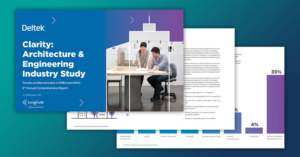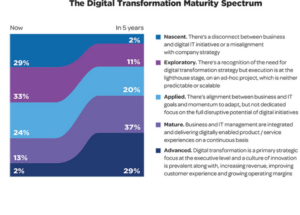General Business Strategy
Top Three Challenges for Architecture and Engineering Firms in 2024, and How We Can Help.
When you enjoy what you do, it’s easy to get lost in the work. Hours, weeks even months can fly by as you’re focussed, in our particular case, on helping clients grow their businesses.
We work with several Architecture and Engineering firms and see common challenges arising and our observations were recently confirmed by a major piece of international industry research that surveyed 549 Architecture, Engineering and Consulting firms from Australia, New Zealand, Germany, Nordics and the UK.
So on the approach to the holidays, we decided to stop, and take a big picture look at the sector.
Some of the issues are widely experienced, such as cybersecurity and the impact of AI, and some are more unique to Architecture and Engineering firms.
You can download the full report here, however, allow us to provide a few highlights, which I sure will strike a chord, followed by solutions that have helped our clients overcome many of these issues already.

Main Challenges, And Top Three Priorities
You may not need to be reminded of the macro challenges we’re all facing right now – rising energy costs, inflation, interest rates, a struggling economy, the rise of AI and its unknown implications, talent shortages are the ones we deal with daily. And that’s to say nothing of the ongoing challenge of profitability and business growth.
Looking at all that, how on earth do you, as a business determine your priorities and develop a strategy to navigate through it all not only to survive, but actually thrive in the uncertainty…?
Well, according to the 549 Architecture, Engineering and Consulting firms surveyed, the top three priorities for their business are as follows:
- Investing in new technology
AI, cyber security, advanced project management technology and effective use of the cloud are just some of the technology issues and opportunities faced. Collectively, they amount to the number one priority. Fair to say it’s early days in the sector’s digital transformation and much opportunity and work remains.
Of all organisations surveyed, and SMEs were found to be the furthest behind in their digital transformation journey.

- Expanding into new markets
Focussing on growing your business is the best way of facing down economic uncertainty, recession and rising interest rates. And while many firms are looking to do this by increasing revenue from existing clients, that’s a finite well and most are rightly focussed on expanding into new markets as well. However, the approach is sub-optimal; business focused on their core skillset would be well advised to bring in the different skills necessary to create clear growth strategies.
Despite the fact that this is the number two priority, 53% of all business admitted they didn’t have a clear strategy for business growth.
- Attracting new talent
The number one ‘people issue’ on everyone’s minds is the difficulty in attracting and retaining talent. And, given the fact that 67% of all the organisations surveyed intend to increase their headcount, this is quite a problem. Never mind the fact that if you successfully expand into new markets, you’re going to need more people to service the business.
53% of firms turned down work because of resourcing issues.
Does any of that resonate with your experience? Well, if so, read on, because in the last year or two we’ve helped a number of firms in this sector expand into new markets and build powerful employer brands that deliver an edge in the fight for great talent. Granted, investment in technology is not in our wheelhouse, however by growing your business we help make investments more comfortable.
Let’s examine expanding into new markets first.

Expanding into new markets, step–by–step.
Identify and Research you Opportunity
If you’re going to expend time, energy and finances it’s a good idea to confirm you’re spending it in the best place possible. Hence, your first step should be to search for profitable under-serviced gaps in the market that you might be able to fill from within your skillsets; use a combination of experience, gutfeel and basic feasibility work.
Formal research is expensive, but there’s a lot you can do without it. Look for any existing research, such as the report we’ve quoted above, read through competitors’ websites to see who’s strong and what they’re doing weak … and the opposite. Perform keyword research to find out what people are looking for online. Most importantly, don’t be afraid to talk to people in the space, not to sell, but just to learn.
Will you know everything about the space you’re eying off? No, but in reality, you never will until you give it a crack. So, knowing you’ll be ready to fail fast, if necessary, once you’ve settled on your target, you’re ready to plan your attack.
But before you do, you’ll need to ensure you have someone to own, and drive this internally. If you don’t have the skills on your team, don’t just reach out externally; since you’ll be in an exploratory mode you won’t be able to provide sufficient guidance to an external resource and after all, the best ideas come from inside any business. (We’ve developed a way to bring skills into client businesses, so there are options, but you can explore our site to learn more about that at your leisure).
Strategic Value Proposition and Key Messaging development
With the insights you’ve gained on the new target in mind, what will you want to present to them to get engagement? Review your existing brand and messaging to see what works and what you need to adjust or add. Chances are, it’s not going to be perfect fit, and you’ll need to develop a new customer value proposition at least, to address the new market. Do you need to develop a sub-brand, a new range of collateral that targets their pain points more specifically, new content that demonstrates your authority and credibility, new web pages..?
Once again this is specialist strategic work that you should involve a marketer with.
Marketing Tactics Implementation
Now you can plan a range of marketing activities that serve, and support your marketing strategy, develop the best way to reach the new market to present your business. Where will you reach them, via what channels and when? What are the competitors doing and spending? How will you get noticed? How will you generate leads?
Monitor and Optimise
You’ll be on a steep learning curve, so don’t forget to build in a series of relevant metrics to monitor, so you can track your progress towards ultimate success – whether that’s number of clients or a certain level of new market penetration – as well as interim markers such as leads flow.
Now, that’s a quick overview of a very thorough process, however it’s one we know inside out, so if you feel you could do with some help, please just give us a call. In the meantime, let’s move onto the issue of talent.
Developing a marketing strategy for growth is probably the most important factor in all of this, and we were shocked to hear that 53% of all firms surveyed didn’t have one in place.

Attracting new talent, developing your employer brand.
If people with talent are difficult to come by, you need to make your business as attractive a place to work as possible. And that means more than just a well written job ad, even a generous salary isn’t the drawcard it used to be.
The process of developing your employer brand is actually quite similar to the one we’ve just discussed. You need to understand your target market (future employees) find out what they want (and what they need) uncover what you competitors are offering, and develop your position accordingly.
This probably won’t lead to a repositioning of your brand and overall business, but it could, perhaps, lead to the development a range of new initiatives, and benefits, that future employees will enjoy in good time, and existing employees will enjoy right now.
A section on your website, then, would be created to shine a light on all of this. In addition to the traditional range of employee benefits, a clear vision and purpose for the business can be a distinguishing and desirable feature, as can visible Corporate Social Responsibility activities.
Importantly, don’t forget half the battle is retaining staff. How good are you at presenting your brand internally? It can make a huge difference to think about marketing internally. We’ve written all about this here, and how it can significantly affect your chances of success.
The Inside Out Solution
There’s obviously more to all of this, but we have to draw the line somewhere and hopefully we’ve given you a little enlightenment, and touch of guidance as you ponder the growth of your business over the holidays.
If you’re thinking it all looks a bit complicated, then you’re right, which is why we’ve developed a new way for SMEs to access the senior talent they need to grow their business, without paying for a full-time employee.
Because not addressing business challenges just isn’t an option, and doing it badly wastes your time, and your money too. So please, contact us instead, for advice at least about getting the marketing resourcing and strategic component right. You really should be across all the options.




